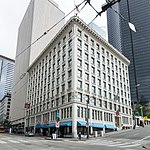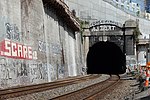Grand Opera House (Seattle)

The Grand Opera House in Seattle, Washington, US, designed by Seattle architect Edwin W. Houghton, a leading designer of Pacific Northwest theaters, was once the city's leading theater. Today, only its exterior survives as the shell of a parking garage. Considered by the city's Department of Neighborhoods to be an example of Richardsonian Romanesque, the building stands just outside the northern boundary of the Pioneer Square neighborhood.The building at 213–217 Cherry Street, Seattle, Washington was originally owned by John Cort, of Cort Circuit fame. Opened in 1900, after Cort convinced the city to extend the northern border of its official entertainment district north from Yesler Way to Cherry Street, it was the city's leading theater of the time. It survived a November 24, 1906 fire, but after it was gutted by another fire in 1917, it was converted to a parking garage in 1923.The reign of the Grand as Seattle's leading theater was relatively short. Cort himself was one of the reasons for this, when he made Seattle's Moore Theatre, also designed by Houghton, his flagship house after its December 28, 1907 opening. The 1911 opening of the showpiece Metropolitan Theatre in the Metropolitan Tract further eroded the Grand's position. By the time a January 20, 1917 fire gutted the building, it had become a movie theater.After the 1917 fire, the building sat empty for several years before becoming a multi-level parking garage in 1923.
Excerpt from the Wikipedia article Grand Opera House (Seattle) (License: CC BY-SA 3.0, Authors, Images).Grand Opera House (Seattle)
Cherry Street, Seattle International District/Chinatown
Geographical coordinates (GPS) Address External links Nearby Places Show on map
Geographical coordinates (GPS)
| Latitude | Longitude |
|---|---|
| N 47.6031 ° | E -122.3323 ° |
Address
Cherry Street Garage
Cherry Street 213
98104 Seattle, International District/Chinatown
Washington, United States
Open on Google Maps










